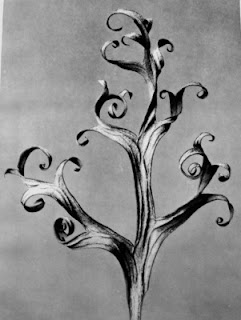There are seven formal elements:
LINE
COLOUR
FORM
SHAPE
SPACE
TEXTURE
LIGHT
These elements are key to our undertstanding of visual analysis and developing our own artistic practise.
Line
Line is a human invention, something we need in order to communicate what we see.
Line can be used in a number of ways:
in a painting lines can occur by contrasts of light and shadow or through colour or shape.
Whether seen or implied, line is unquestionably one of the artist's most articulate tools.
It encloses or liberates space expresses feeling conveys movement suggests mass or volume creates an image.
It may be used evenly or in a modulated way to express a wide range of qualities :
from fast to slow from serene to frenetic or rigid to relaxed.
I used Edward weston as a starting point for my own photograph.
This is because i wanted to use the use of line in my own picture.here the use of lines
help the eye read teh image. in teh Westin photograph the lines create a direction.
in my own photo the lines centre the image and tells the eye how to read the photo.
Colour
It could be said that colour is the most important element of Art. How we see colour is affected by our environment, culture and reitnal ability. Colour effects our emotions, natural instincts and our very wellbeing. Colour has no boundaries, it affects every aspect of life.
Form
Form has mulitple meanings in Art.
As a verb (to shape and create)
the organisation and composition of a piece of work
the illusionary representaion of something three dimensional on a two dimensional surface.
A mold in which a meterial is poured
A three dimensional solid or contained space
Glenn Brown
Glenn brown's style of painting uses the technique called 'trompe l'oeil' .
(french for 'trick of the eye')
Trompe l'oeil is the technique using extremely realistic imagery in order to creath th optical illusion that the painting is a three dimensional object.
While this painting appears textured with thick brushstrokes and layers of paint, in reality this oil on board is extremely flat using the finest of brushstrokes.
In my own work my photos were very close up showing every detail and in my drawings and paintings i focused on the shading toning of the picture therefore creating a very detailed and realistic work that almost creates a three dimensional form, similar to Brown's work.
Shape
Shape has three fundamental purposes in art:
To portray a physical form.
To achieve a harmony and order in a composition.
To express the different qualities of moods and feelings.
The term 'shape' refers to any area of real or imagined object created and rendered using the all other formal elements.
Shape is different to form because while form has mass and volume, shape is only two dimensional.
Karl Blossfeldt
Space
Nothing can exist without space
Texture

'tool drawing' Jim Dine
Light












































